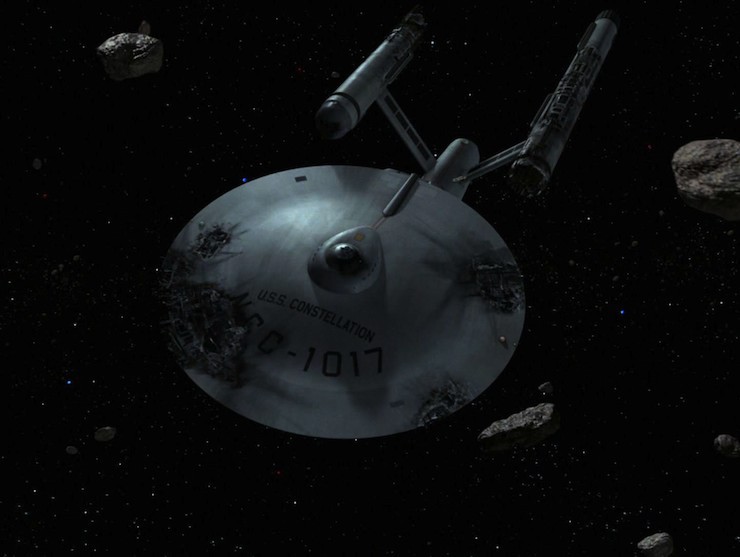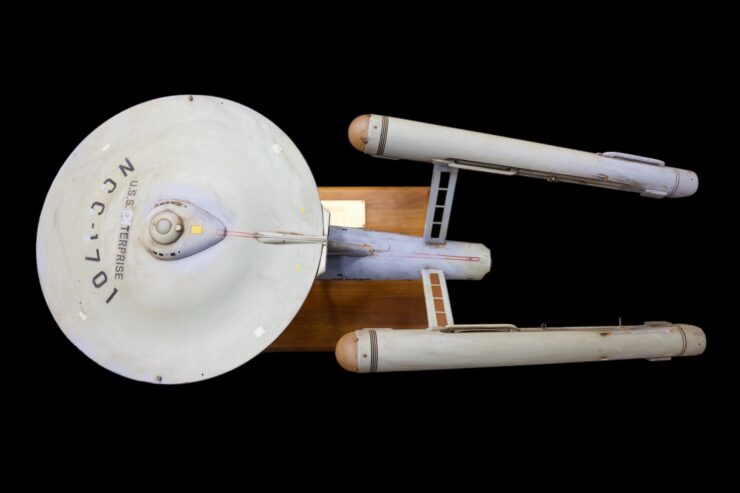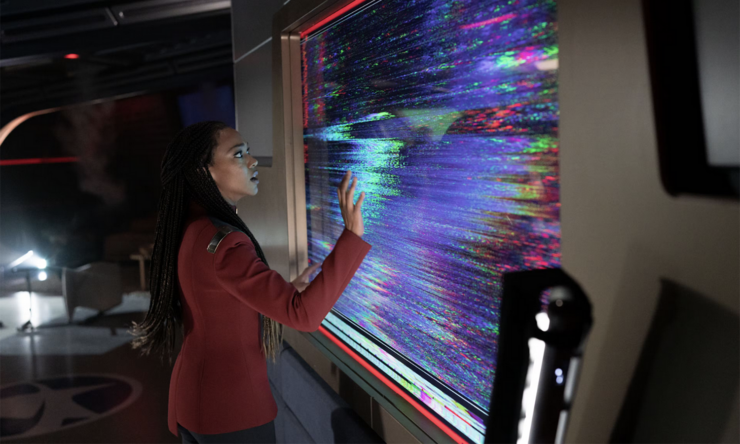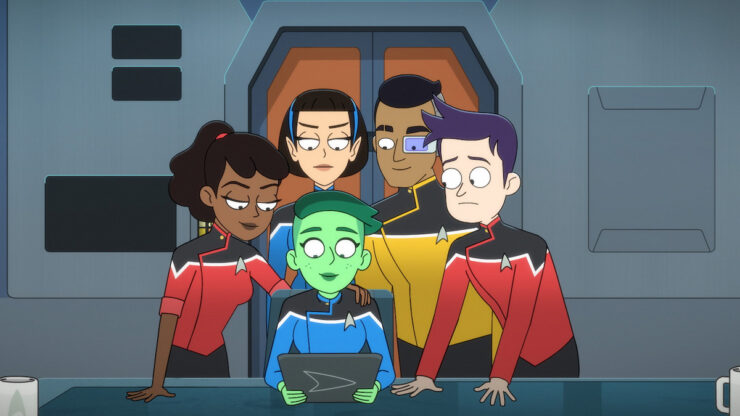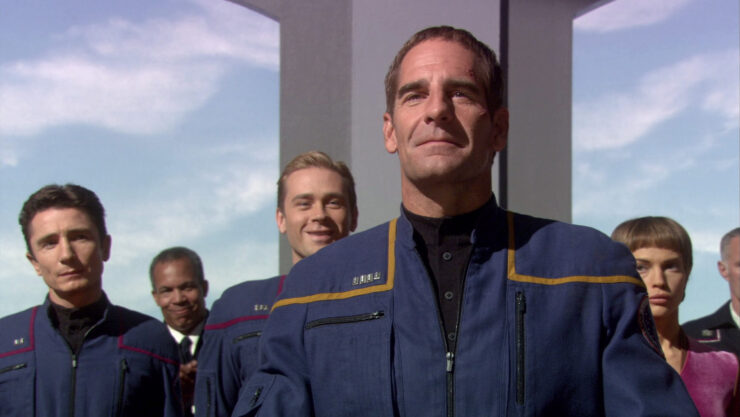“The Doomsday Machine”
Written by Norman Spinrad
Directed by Marc Daniels
Season 2, Episode 6
Production episode 60335
Original air date: October 20, 1967
Stardate: 4202.9
Captain’s log. The Enterprise is following a garbled distress signal from the U.S.S. Constellation, but they arrive at the source to find a destroyed star system: L-370, which had seven planets a year ago when the Enterprise mapped it, is now just debris and rubble. But the star’s still intact.
They track the destruction through three more star systems, all destroyed in the same way. In L-374, the two innermost planets are still intact, and they also find the Constellation adrift, an automatic disaster beacon the only communication. They’ve got very low reserve power, and that’s it. There’s also a lot of subspace static—Lieutenant Palmer at communications is having trouble breaking through it.
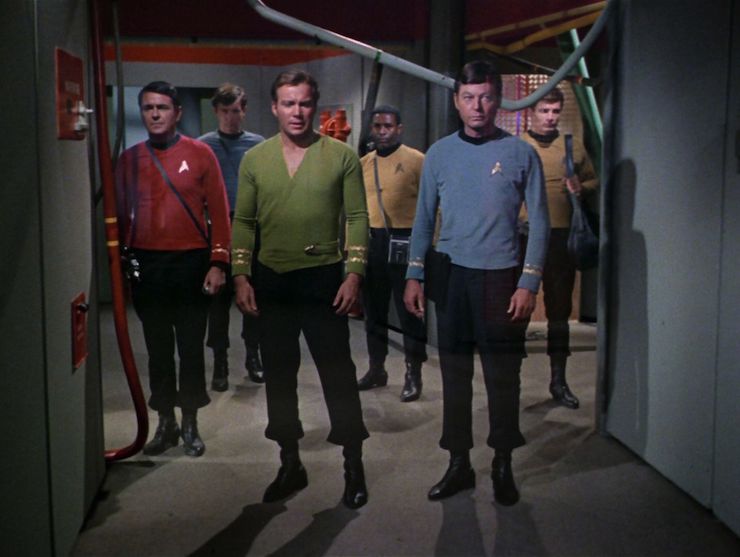
Kirk calls red alert. There are no other vessels in the area, and life-support is still intact on most of the ship, though the bridge is uninhabitable. Kirk downgrades to yellow alert, but maintains battle stations, and he beams over with McCoy, Scotty, and a damage-control party, leaving Spock in charge of the ship.
They find no survivors, but also no bodies. No half-empty cups of coffee or abandoned food. But the only two planets left in the system are inimical to human life. Scotty reports that the warp engines are completely shot, but impulse drive is intact and possibly repairable, and also that phaser banks are completely exhausted—they didn’t give up without a fight.
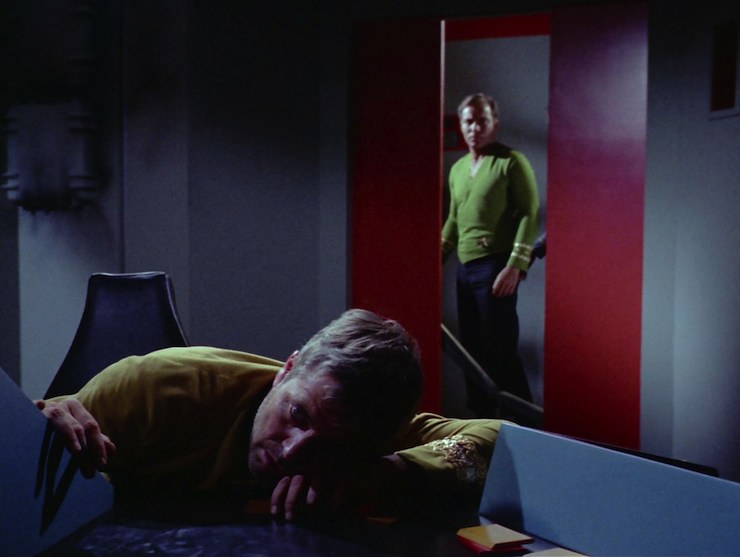
They go to auxiliary control to play the captain’s log, but upon arrival, they find something better: Commodore Matt Decker, the CO of the Constellation. He’s in shock. McCoy is able to revive him, though as soon as Kirk asks what happened, just the idea of mentioning what attacked the ship almost sends him back into a catatonic state.
Scotty plays the log. The Constellation encountered the same destroyed solar systems the Enterprise did, and also the same subspace interference Palmer reported, keeping them from contacting Starfleet Command. They investigated L-374, where the fourth planet was breaking up. The thing that destroyed the solar systems also beat the crap out of the Constellation. Decker says it’s miles long, with a huge maw through which it shoots an anti-proton beam (which actually deactivated the antimatter in the warp drive). They had to abandon ship on the third planet. But the thing hit again before Decker himself could beam down (he was the last one on board, as is proper), wiping out the transporter.
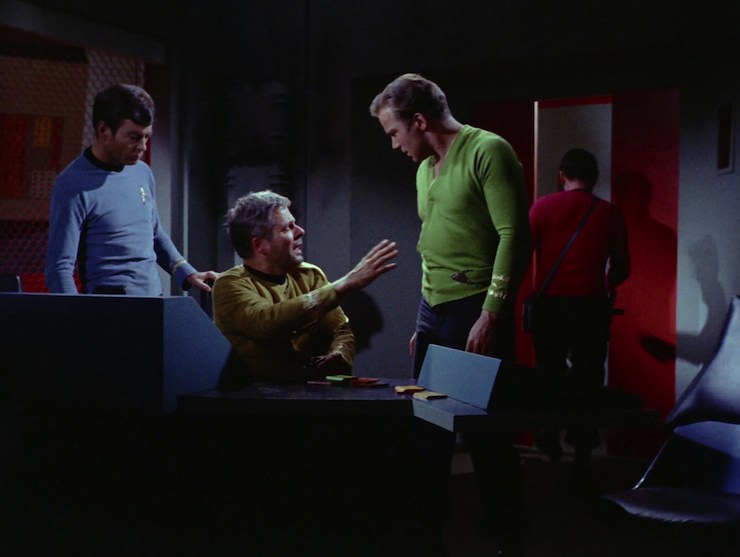
Kirk points out that there is no third planet, and Decker loses it again—he had to sit helpless as the thing destroyed the third planet with his crew on it.
Spock’s view of the Constellation sensor logs leads him to hypothesize that it’s a robot that is self-sustaining by destroying planets for fuel. Sulu has traced the planet-killer’s course, using the devastated solar systems as a base: it came from outside the galaxy, and is currently heading for the Rigel colonies, the most densely populated section of this galaxy.
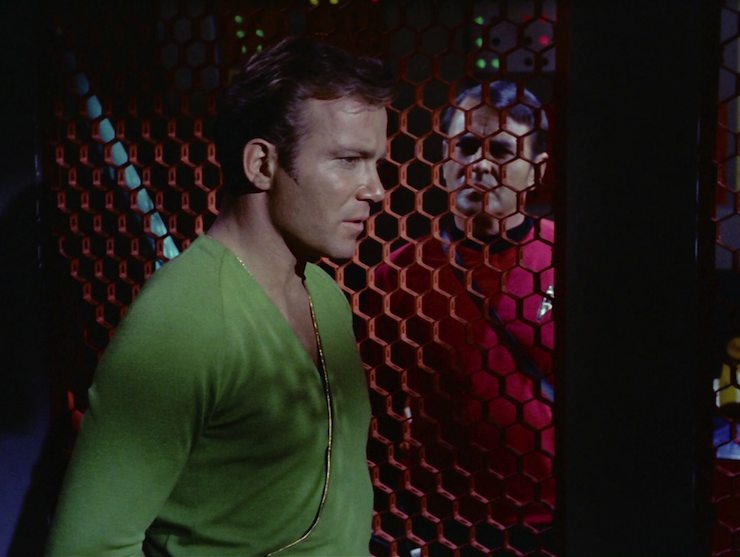
Kirk thinks it might be a “doomsday machine,” an ultimate weapon meant to be used as a bluff—mutually assured destruction, like the hydrogen bomb during the Cold War of the 20th century.
Decker and McCoy beam back so the latter can take care of the former, but as soon as they materialize, Spock signals red alert, so they run to the bridge. The planet-killer has shown up out of nowhere and is pursuing the Enterprise. Before Spock can beam the damage control team back, the planet-killer hits them, wiping out the transporter, and also damaging communications so they can’t pierce the planet-killer’s subspace interference.
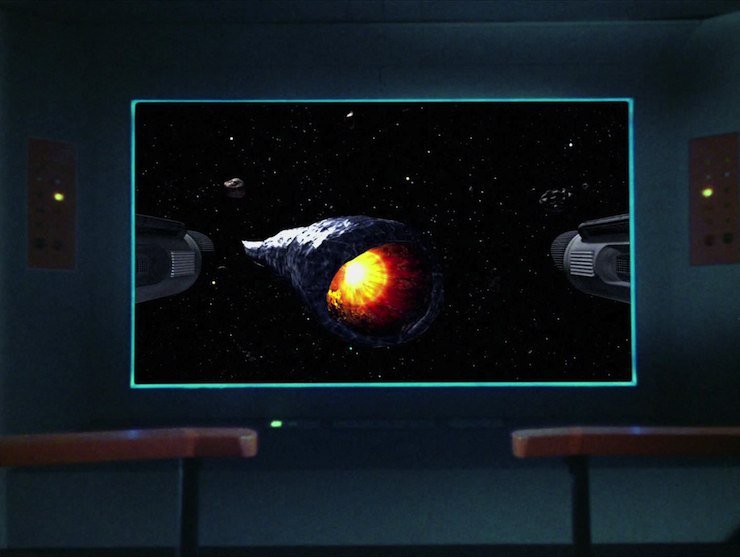
No longer able to contact the Enterprise, the Constellation is blind, deaf, and paralyzed. Kirk orders Scotty to get the impulse engines working while he and Washburn work on the viewscreen.
On the Enterprise, Decker asks Spock for a status report. They’ve managed to outrun the thing, and the planet-killer is now veering off and heading back to Rigel. Spock figures it ignores something as small as a starship outside a certain radius.
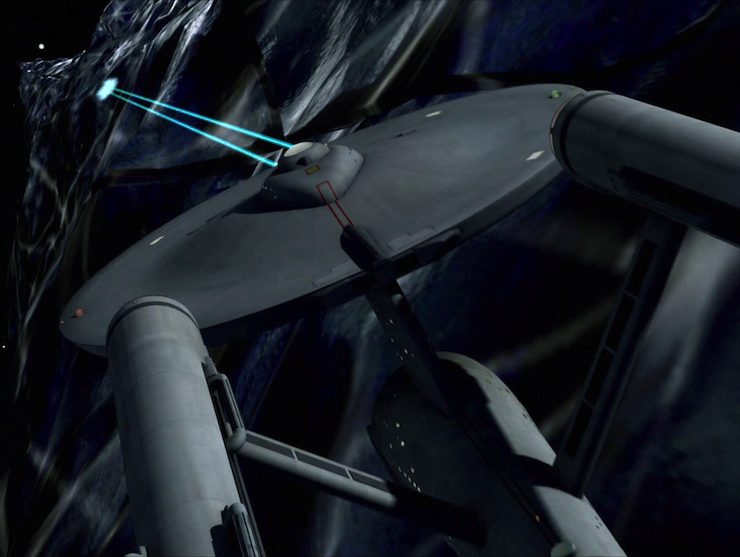
Spock’s plan is to circle back and pick up Kirk and the boarding party, then get out of the planet-killer’s subspace jamming to contact Starfleet and warn the Rigel colonies. Decker dislikes that plan, and orders Sulu to set course for the planet-killer to attack it—this time at point-blank range with full phasers. Decker is a commodore and therefore has the right to assume command under regulations, and he exercises that right. Spock advises him against it—the planet-killer’s hull is neutronium, and one starship can’t fight it. Decker tells him he’s relieved of command, and if he doesn’t shut up, he’ll relieve him of duty as well.
They head for the planet-killer. As soon as they get close enough, they’re hit with the anti-proton beam, which does a number on the deflectors. Decker insists on moving closer.
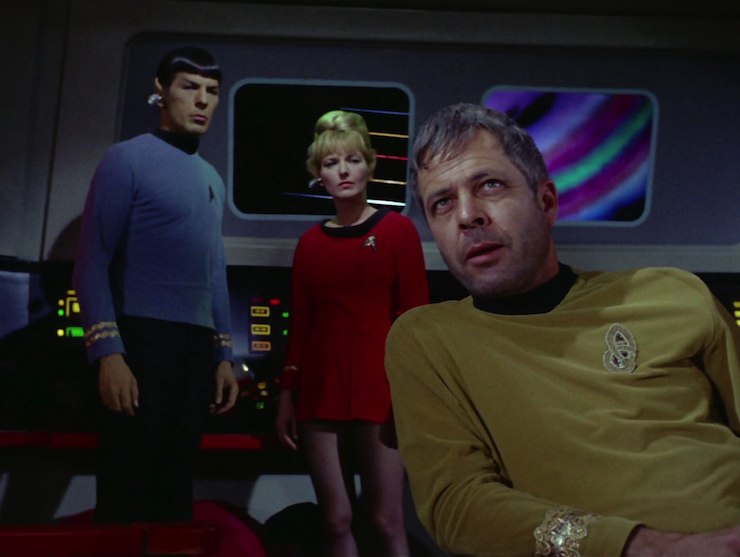
On the Constellation, Scotty has to cross-connect, as the impulse control circuits are fused, so he has to use the warp drive control circuits to manage the impulse drive. Kirk and Washburn get the viewer working just in time to see the Enterprise firing on the planet-killer at point-blank range. Kirk is appalled. Sulu is equally appalled to see that his direct phaser hits all just bounced off with no effect.
The planet-killer hits again, wiping out deflectors, then hits the Enterprise with a tractor beam, pulling it in the way it pulls planetary debris in. Warp drive is now down also. Decker insists on still trying to attack rather than break free, but Spock points out that that is suicide, and grounds for relieving him of duty. Decker reluctantly orders Sulu to veer off—but unfortunately, the Enterprise doesn’t have enough power to pull out of the tractor beam.
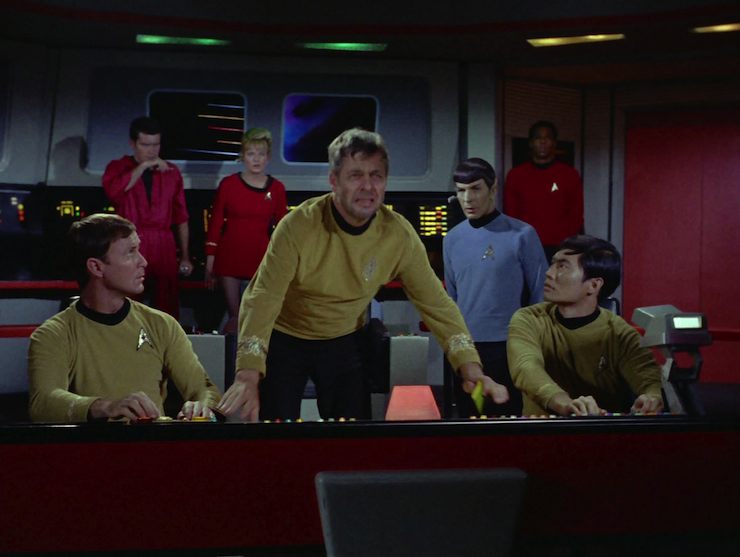
Scotty gets impulse engines working, and Kirk pilots the Constellation toward the planet-killer. It is, to say the least, a rough ride, but Kirk soon gets the ship under control. Scotty also has a phaser bank recharged, so Kirk fires a shot at the planet-killer. The good news is that it releases the Enterprise. The bad news is that it’s now turning its attention to the Constellation.
Decker returns the favor, firing phasers on the planet-killer, then pulling away. The planet-killer gives chase, but Spock warns that with only impulse power they are limited in how long they can stay ahead of it, especially since it can refuel easily.
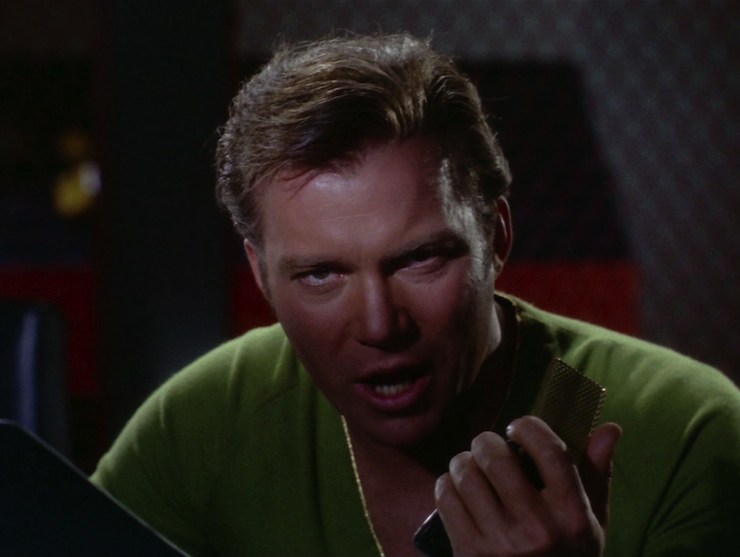
Palmer is able to pierce the interference locally and raise Kirk—who is beyond livid to discover that Decker has nearly destroyed his ship. Kirk orders Spock to relieve Decker on his personal authority as captain of the Enterprise. Decker resists until Spock threatens to put him under arrest—and the two security guards on the bridge are quite ready to do so. Decker reluctantly turns command back to Spock and is escorted to sickbay by one of the guards. Spock then orders Sulu to circle back to pick up Kirk and the boarding party.
Decker jumps his security escort and sneaks to the shuttle bay. He steals a shuttle and pilots it for the planet-killer. Kirk and Spock both try to convince Decker not to throw his life away, but Decker insists on piloting the shuttle right into the planet-killer’s maw.
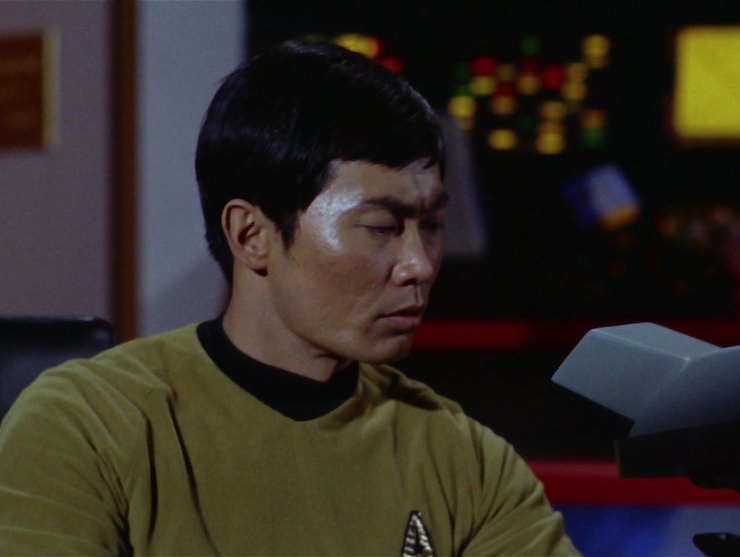
Sulu picks up a minute drop in power when the shuttlecraft exploded. It’s a negligible loss, but it gives Kirk an idea: do the same thing, but with something bigger. Like, say, the Constellation. The transporter’s now working again, so Kirk orders the damage control party beamed back, leaving only Scotty and Kirk on the Constellation. He plans to detonate the impulse engines, using a thirty-second detonation that Scotty has rigged so he can beam back after it’s activated.
However, when Scotty beams back, the transporter goes wonky. Scotty jury-rigs a fix, so Kirk activates the detonation—and then the transporter goes down again. Scotty again jury-rigs a repair and Kirk’s beamed out in the nick of time. Best of all, it works, the planet-killer is now completely inert. Kirk comments on the irony of using something very much like the 20th-century version of a doomsday machine (a hydrogen bomb) to destroy another doomsday machine.
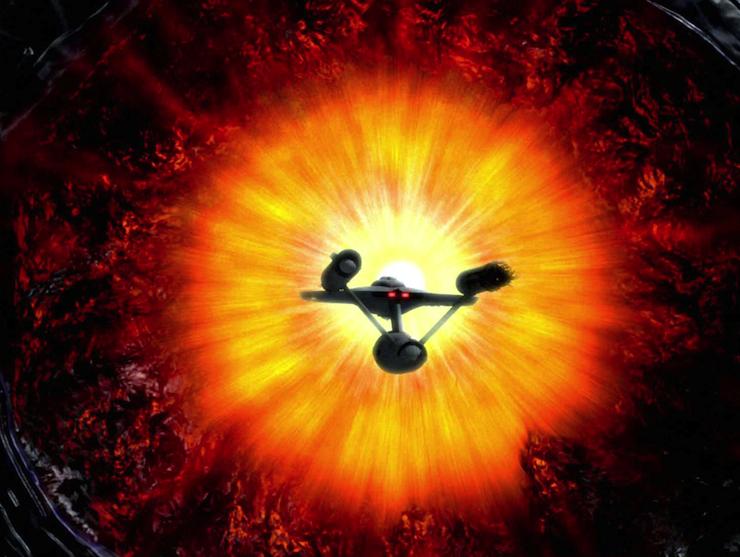
Can’t we just reverse the polarity? Scotty is able to rig the warp drive control circuits to control the impulse drive, get the impulse engines working, and recharge a phaser bank. For an added bonus, he fixed the transporter—twice. Because he’s just that awesome. (He also rigs the thirty-second detonation of the impulse engines, but by his own admission, that’s easy—the hard part is keeping them from blowing.)
Fascinating. Spock remains a stickler for regulations. He advises against Decker relieving him of command, but ultimately steps aside. Afterward, he just stands to the left of the command chair and pointedly stares blankly into space, not even moving to the science station. It’s an interesting form of civil disobedience, as he obeys the letter of regulations, even talking McCoy into not challenging Decker’s competence (because he knows he doesn’t have a leg to stand on), but doesn’t do anything to help Decker, either. He finally takes the science station when it’s absolutely necessary, once they engage the planet-killer. And when he gets a direct order from Kirk, then he relieves Decker…
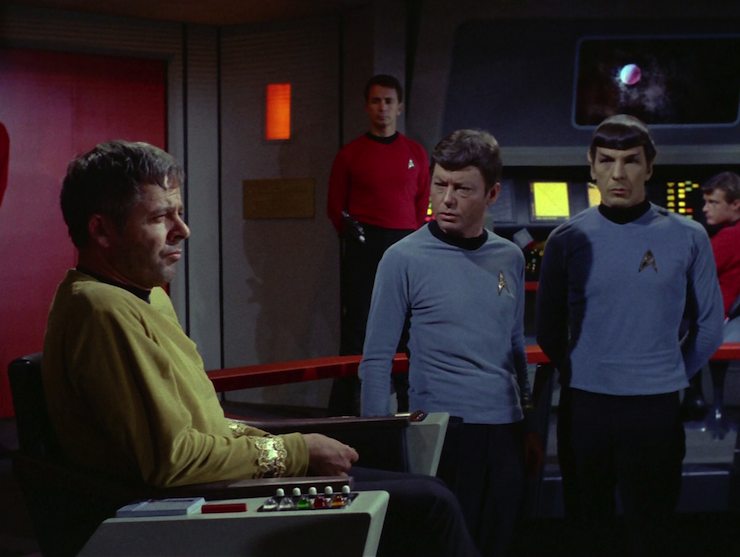
I’m a doctor not an escalator. McCoy’s best line in this episode isn’t actually in this episode. When Decker kicks him off the bridge, the commodore points out that Spock knows his duty under regulations—”do you?” In the episode, McCoy grumpily leaves the bridge without a word, but in his adaptation in Star Trek 3, James Blish gave the doctor the retort: “Yes, sir…To go to Sickbay and wait for the casualties you’re about to send me.” Honestly, for years, I thought that line was part of the episode, it created such an impression on me.
And not just me—the line did wind up being used by an Enterprise chief medical officer to someone in temporary command of the ship: by Beverly Crusher to Captain Jellico in “Chain of Command, Part II.”
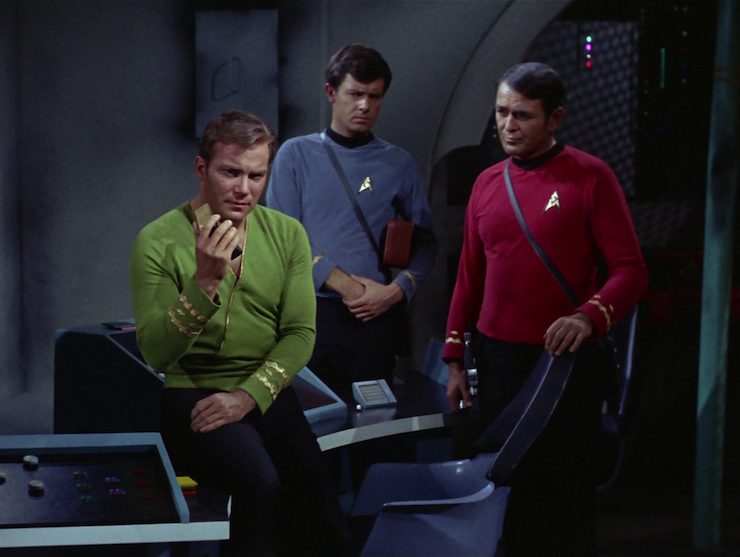
Ahead warp one, aye. Sulu is pretty much responsible for saving the day, as he’s the one who notices the power drop when Decker’s shuttle blew up, which is the key to stopping the planet-killer.
I cannot change the laws of physics! The one and only time James Doohan ever loses his Scottish accent on the show is in this episode, when he’s showing Kirk which switch he’s rigged for the detonation. When he says, “thirty seconds,” it’s in his normal voice.
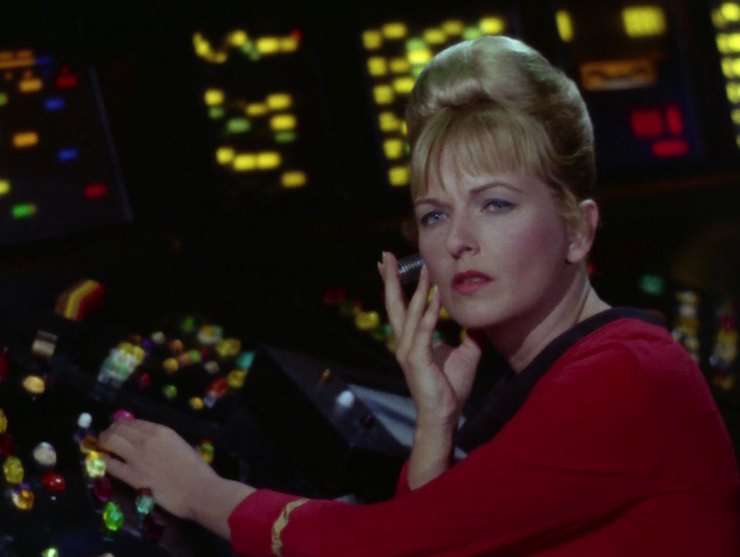
Hailing frequencies open. While we’ve seen lots of different people at helm and navigation, this is only the second time since “The Corbomite Maneuver” that we’ve seen someone other than Uhura at communications, the other being Farrell in “Miri.” This time it’s Palmer.
Go put on a red shirt. Twice, the guard assigned to Decker falls for the tired-old-man shtick. First Decker pretends to have a coughing fit, using that as cover for his first time hitting the guard. Then a few minutes into the fight, Decker pretends to be winded and exhausted, and again uses it as cover to hit the guard.
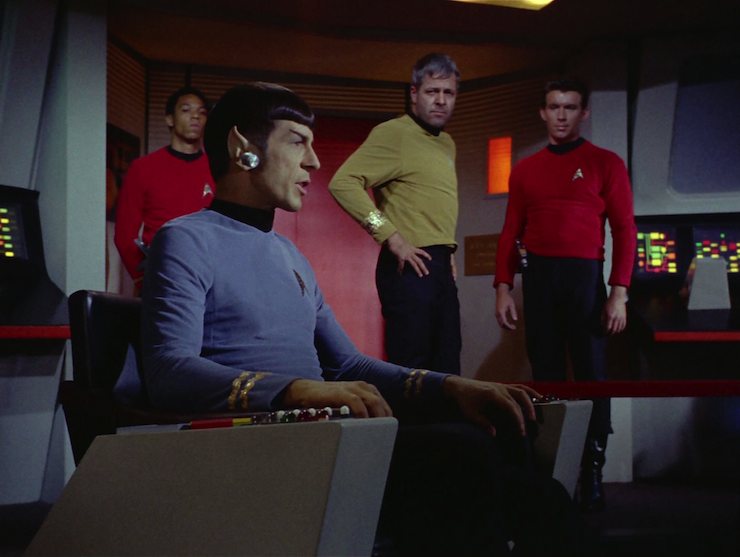
More generally, this trained security guard is incapable of taking down a much older commodore who’s physically and emotionally exhausted from quite possibly the worst trauma of his life, and instead has his ass handed to him.
Channel open. “Random chance seems to have operated in our favor.”
“In plain, non-Vulcan English, we’ve been lucky.”
“I believe I said that, Doctor.”
Spock and McCoy doing the usual banter.
Welcome aboard. The damage control team is played by Richard Compton, John Copage, and Tim Burns. The three characters were named after assistant directors on the show: Charles Washburn, Rusty Meek, and Elliot Schick.
Elizabeth Rogers makes her first of two appearances as Palmer; she’ll return in “The Way to Eden.” Rogers previously did the voice of the Companion in “Metamorphosis.” And we’ve also got recurring regulars George Takei, James Doohan, and John Winston.
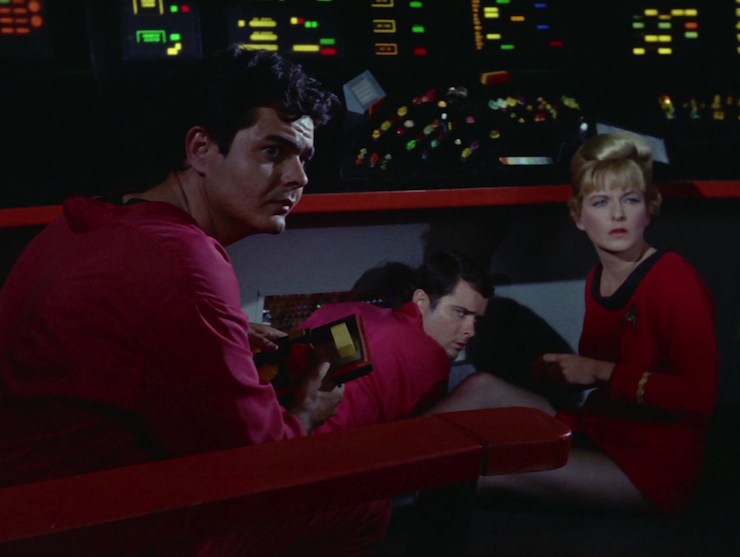
But the big guest is the great William Windom as Decker. He fully inhabits the role, giving him all kinds of wonderful little tics and habits, from the awkward way he sits in the captain’s chair to the way he plays with the data tapes (which Windom has said was inspired by how Humphrey Bogart fiddled with ball bearings when he played Captain Queeg in The Caine Mutiny). He’s a very lived-in character, one of the best guest stars in the show’s history. (Amusingly, writer Norman Spinrad envisioned Robert Ryan in the role when he wrote it, and the producers did try to get Ryan, but he was unavailable.)
Trivial matters: Though it was never explicitly stated onscreen, it was always intended for Willard Decker in The Motion Picture to be Matt Decker’s son. All of Willard’s appearances in tie-in fiction has been written with that in mind.
Your humble rewatcher showed the entire crew of the Constellation in The Brave and the Bold Book 1, establishing the first officer, chief medical officer, and security chief, as well as several other minor characters, and also fleshing out the only other named crew member, Science Officer Masada. That story took place about a year prior to this episode and chronicled the first meeting between Kirk and Decker (since they obviously knew each other in this story). David Mack also portrayed that same crew in Vanguard: Harbinger as well their Mirror Universe counterparts in The Sorrows of Empire.
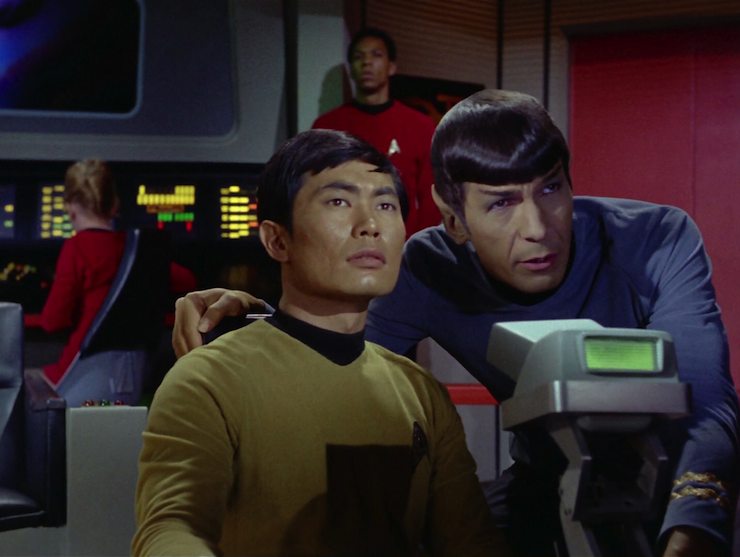
Palmer appears in a few tie-in stories, as well, including the short stories “Under Two Moons” by William Rostler in Star Trek II Stories and “Fracture” by Jeff Bond in Constellations, as well as the Mere Anarchy novella The Centre Cannot Hold by Mike W. Barr.
Peter David‘s novels Vendetta and Before Dishonor established that the planet-killers were originally created to combat the Borg.
Voyager encounters another planet-killer in the comic book miniseries Planet Killer by Dean Wesley Smith, Kristine Kathryn Rusch, Robert Teranishi, & Claude St. Aubin.
This is the first time we see another ship of the Enterprise‘s class.
The new engineering set debuts in this episode, which has more space and a second level. (Technically, it’s the Constellation‘s engine room, not the Enterprise‘s, but the same set will be used on the latter moving forward.) This is also the first time we see auxiliary control.
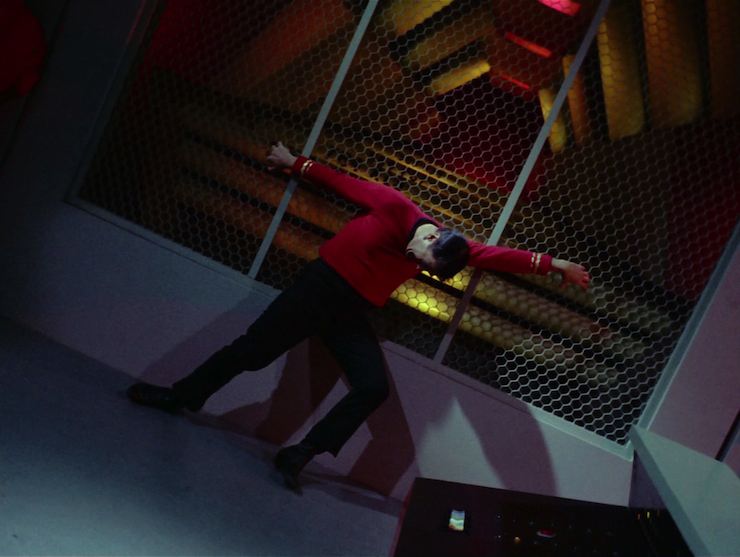
We also see Kirk’s new green alternate tunic, similar to the one from “The Enemy Within,” but with some variations. Kirk will periodically wear it throughout this season.
Norman Spinrad’s story (originally called “The Planet Eater”) took its inspiration from Moby-Dick by Herman Melville. It’s far from the last time that novel would inspire a Trek story—see also “Obsession,” The Wrath of Khan, and First Contact.
Spinrad’s original screenplay had Decker’s first name as “Brand” and didn’t have the commodore’s suicide mission with the shuttlecraft. Instead, Decker lived and decided to retire. Those aspects were seen in James Blish’s adaptation in Star Trek 3.
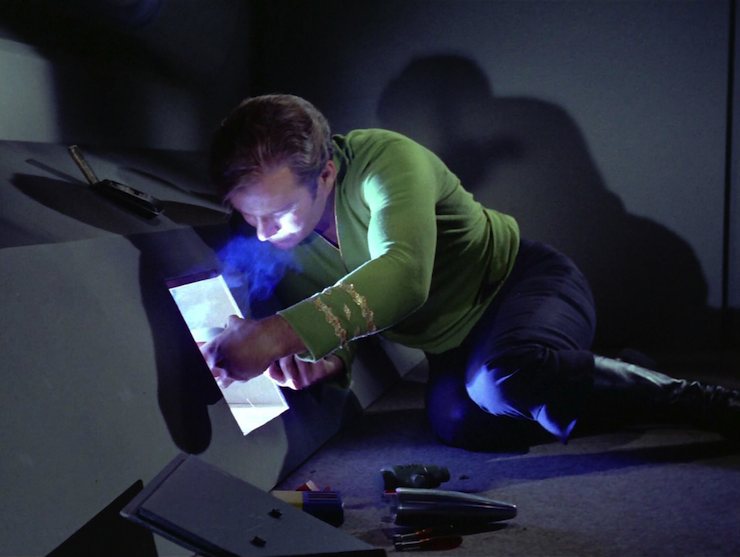
Spinrad wrote two more scripts for Trek that were never produced, “He Walked Among Us,” which he withdrew after he was unhappy with Gene L. Coon’s rewrites, and “To Attain the All,” which was written for the abortive Star Trek Phase II series in the 1970s (that series was scrapped in favor of The Motion Picture). Spinrad rewrote He Walked Among Us as a novel with original characters, and will also be directing the original Trek script for the Phase II fan film series.
When the original series episodes were remastered in 2007, this episode received some of the most changes, with 105 new effects shots (most of the remastered episodes had 20-30 new shots).
This episode was nominated for a Hugo Award for Best Dramatic Presentation in 1968. It lost to “The City on the Edge of Forever.”
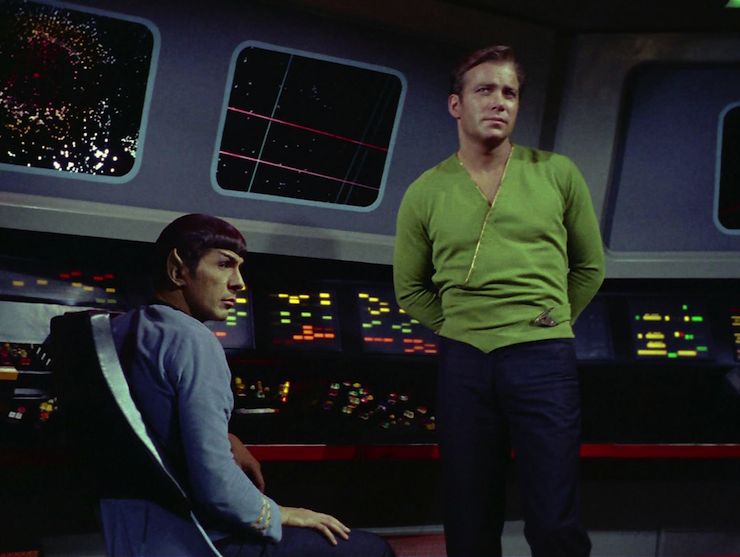
To boldly go. “You worry about your miracles, Scotty, I’ll worry about mine.” I’ve had copies of all the Star Trek episodes on home video since roughly 1987. Initially it was on VHS tapes, recorded off of Channel 11 in New York City, and then I picked up the series on DVD, which I still own. (I have not bothered with the remastered editions, not really seeing the point, as nothing of significance is different about them. That’s why there’s been so little discussion of the remastering in these rewatches.)
I like owning stuff I enjoy on some form of home video because sometimes I just like to plunk an episode in and watch it for shits and giggles. There are a few episodes of Homicide: Life on the Street I like to just plunk into the DVD player, ditto M*A*S*H, The West Wing, Farscape, Doctor Who, and all the Star Treks.
Whenever I wish to watch an episode of TOS, it’s almost always “The Doomsday Machine” that I pick.
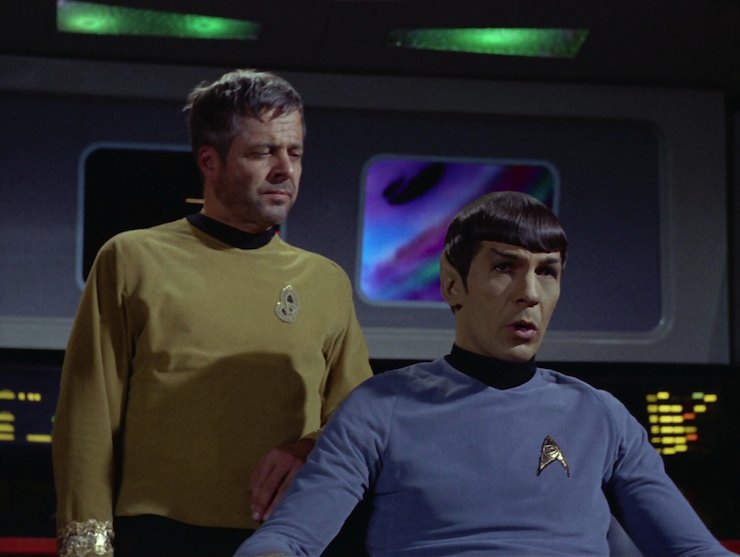
It’s an almost perfect episode. For starters, it’s a strong science fiction story. Norman Spinrad—like Harlan Ellison, Robert Bloch, and Theodore Sturgeon before him—has a strong background as a science fiction writer, and one of the things I particularly love about this episode is that it’s also good science fiction. In particular I like that the script resists the screen SF cliché of Earth always being what’s in danger—the planet-killer’s course takes it to a densely populated section of the galaxy, and it’s not Earth, it’s a set of colonies.
In addition, we have William Windom’s magnificent Decker. Windom brings so much depth to a character who could easily have been a caricature of a crazy person. Unlike, say, Adams in “Dagger of the Mind“—played by quite a fine actor in James Gregory—who was just randomly evil, Decker has very obviously been broken by the loss of his crew. His attempt to make up for it is tragic, but also understandable. And you can just see the stress, the agony, the pain etched on his face throughout.
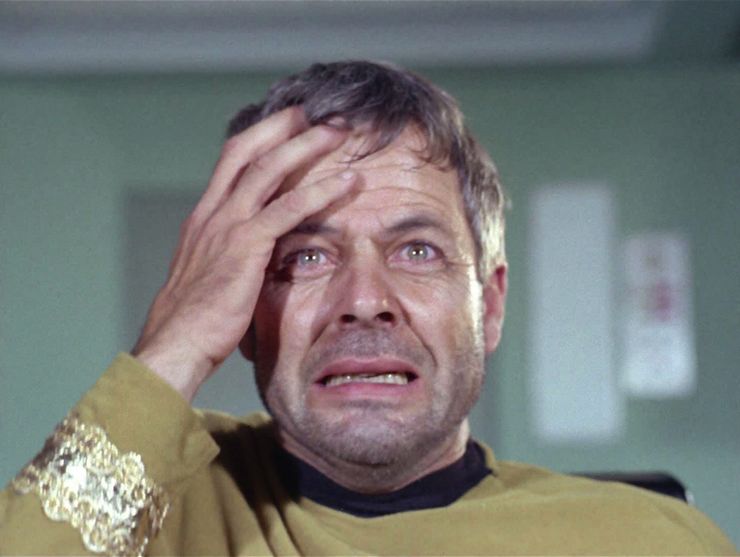
On top of that, it’s an exciting thrill-ride of an episode, a fun high-adventure problem-solving story that wouldn’t be out of place on a Stargate SG-1 episode. The regulars are all at their strongest here. Scotty’s wry banter with Kirk, McCoy’s crankiness, Sulu’s cool competence, Kirk’s unwillingness to just sit around and do nothing, and most especially Spock’s logic and brains.
Where it loses a point is the climax, which is a bit too drawn out. While the slow entry of Decker’s shuttle into the planet-killer is actually quite tense, the final climax is just endless. It takes forever for Kirk to set up the detonation, then the alleged thirty-second delay between Kirk hitting the button and the Constellation blowing up is actually a minute and seventeen seconds of screen time. Yeah. Plus we have to watch Scotty crawl around a Jefferies Tube twice while Leonard Nimoy is stuck saying, “Mr. Scott” in his usual monotone (because his character isn’t emotional, so the urgency is sucked right out).
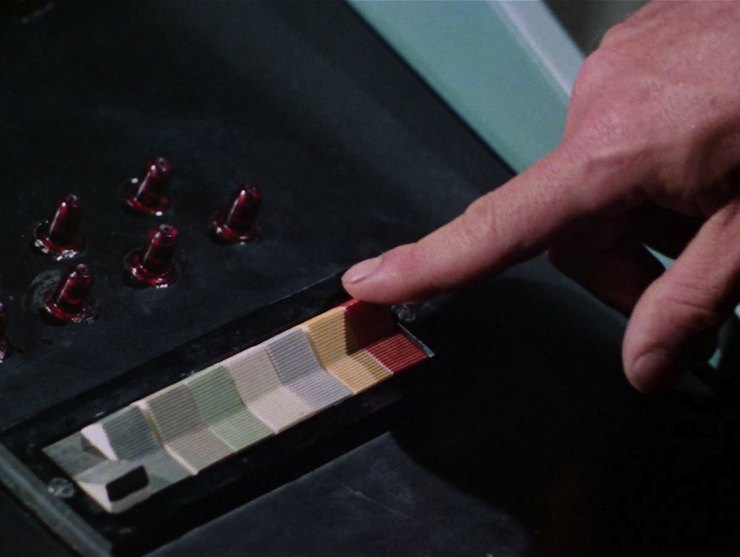
But even with the too-long climax, this is one of the finest hours of Star Trek, just a perfectly put together episode.
Warp factor rating: 9
Next week: “Wolf in the Fold”
Keith R.A. DeCandido will be at Philcon 2015 this weekend in Cherry Hill, New Jersey, along with guests of honor Wen Spencer (author), Richard Hescox (artist), and Murder Ballads (band). His schedule can be found here.










